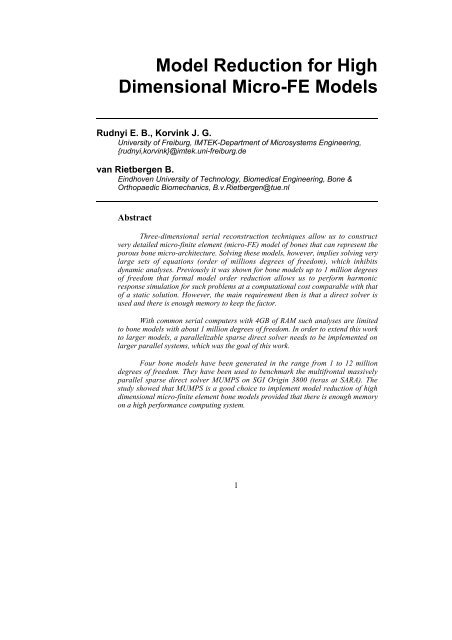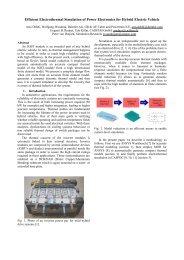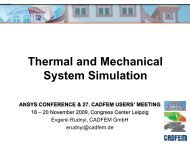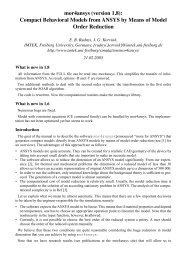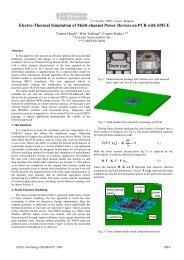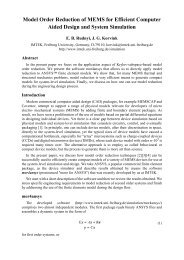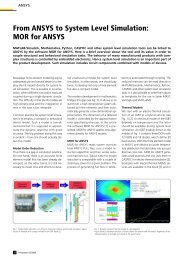Model Reduction for High Dimensional Micro-FE Models
Model Reduction for High Dimensional Micro-FE Models
Model Reduction for High Dimensional Micro-FE Models
You also want an ePaper? Increase the reach of your titles
YUMPU automatically turns print PDFs into web optimized ePapers that Google loves.
<strong>Model</strong> <strong>Reduction</strong> <strong>for</strong> <strong>High</strong><br />
<strong>Dimensional</strong> <strong>Micro</strong>-<strong>FE</strong> <strong>Model</strong>s<br />
Rudnyi E. B., Korvink J. G.<br />
University of Freiburg, IMTEK-Department of <strong>Micro</strong>systems Engineering,<br />
{rudnyi,korvink}@imtek.uni-freiburg.de<br />
van Rietbergen B.<br />
Eindhoven University of Technology, Biomedical Engineering, Bone &<br />
Orthopaedic Biomechanics, B.v.Rietbergen@tue.nl<br />
Abstract<br />
Three-dimensional serial reconstruction techniques allow us to construct<br />
very detailed micro-finite element (micro-<strong>FE</strong>) model of bones that can represent the<br />
porous bone micro-architecture. Solving these models, however, implies solving very<br />
large sets of equations (order of millions degrees of freedom), which inhibits<br />
dynamic analyses. Previously it was shown <strong>for</strong> bone models up to 1 million degrees<br />
of freedom that <strong>for</strong>mal model order reduction allows us to per<strong>for</strong>m harmonic<br />
response simulation <strong>for</strong> such problems at a computational cost comparable with that<br />
of a static solution. However, the main requirement then is that a direct solver is<br />
used and there is enough memory to keep the factor.<br />
With common serial computers with 4GB of RAM such analyses are limited<br />
to bone models with about 1 million degrees of freedom. In order to extend this work<br />
to larger models, a parallelizable sparse direct solver needs to be implemented on<br />
larger parallel systems, which was the goal of this work.<br />
Four bone models have been generated in the range from 1 to 12 million<br />
degrees of freedom. They have been used to benchmark the multifrontal massively<br />
parallel sparse direct solver MUMPS on SGI Origin 3800 (teras at SARA). The<br />
study showed that MUMPS is a good choice to implement model reduction of high<br />
dimensional micro-finite element bone models provided that there is enough memory<br />
on a high per<strong>for</strong>mance computing system.<br />
1
Introduction<br />
Three-dimensional serial reconstruction techniques allow constructing very<br />
detailed micro-finite element (micro-<strong>FE</strong>) model of bones that can represent the<br />
porous bone micro-architecture [1]. Such models can be used, <strong>for</strong> example to study<br />
differences in bone tissue loading between healthy and osteoporotic human bones<br />
during quasi static loading [2]. The main disadvantage of this approach is its huge<br />
computational requirements because of the high dimensionality of the models. This<br />
led to the fact that such computational analyses are limited to a static solution.<br />
There is evidence, however, that in particular high-frequency oscillating<br />
mechanical loads (up to approximately 50 Hz) might play an important role in the<br />
bone adaptive response [3]. Hence, there is a need to extent these static analyses to<br />
dynamic ones.<br />
<strong>Model</strong> order reduction is a relatively new area of mathematics that aims at<br />
finding a low-dimensional approximation <strong>for</strong> a high-dimensional system of<br />
ordinary differential equations. It has been used successfully over the last few years<br />
in different engineering disciplines like electrical engineering, structural<br />
mechanics, heat transfer, acoustics and electromagnetics [4].<br />
Implicit moment matching based on the Arnoldi algorithm [5] is a very<br />
competitive approach to find the low dimensional subspace that accurately<br />
approximates the behavior of a high-dimensional state vector. At IMTEK, software<br />
MOR <strong>for</strong> ANSYS [6] has been used developed in order to per<strong>for</strong>m model reduction<br />
directly to finite element models made in ANSYS. Its computational kernel has<br />
been employed <strong>for</strong> the two bone models of dimensions 130 000 and 900 000<br />
accordingly and it has been demonstrated that model reduction can speed up<br />
harmonic simulation by orders of magnitude on a computer with 4 Gb RAM [7].<br />
The bottleneck of model reduction based on the Arnoldi algorithm is a<br />
solution of a system of linear equations that should take place <strong>for</strong> each Arnoldi<br />
vector [6]. As a result, the use of a direct solver is preferred. However, 4 Gb of<br />
RAM happens to be enough to keep a factor of a bone model up to 900 000 only<br />
[7]. The treatment of models with higher dimensions requires parallel computing.<br />
The goal of the current work is to investigate what dimension of a bone<br />
model one can af<strong>for</strong>d with the multifrontal massively parallel sparse direct solver<br />
MUMPS [8][9]. We first introduce the bone models employed as benchmarks.<br />
After that, we present the results obtained on SGI Origin 3800 (teras at SARA,<br />
http://www.sara.nl/userinfo/teras/description/index.html) and make conclusions.<br />
2
Benchmarks of <strong>Micro</strong>-<strong>FE</strong> Bone <strong>Model</strong>s<br />
The bone models are presented in Table 1. The matrices are symmetric and<br />
positive definite.<br />
The first two models, BS01 and BS10, are from [7]. They have been used <strong>for</strong><br />
debugging the code. The new bone models have been obtained from another bone<br />
sample that was scanned with higher resolution. <strong>Model</strong>s from B010 to B120<br />
represent increasing subsets from the same bone sample.<br />
BS01 BS10 B010 B025 B050 B120<br />
number of<br />
elements<br />
20098 192539 278259 606253 1378782 3387547<br />
number of<br />
nodes<br />
42508 305066 329001 719987 1644848 3989996<br />
number of<br />
DoFs<br />
127224 914898 986703 2159661 4934244 11969688<br />
nnz in half K 3421188 28191660 36326514 79292769 180663963 441785526<br />
Table 1 Bone micro-finite element models<br />
The matrices as well as the driver to call MUMPS are available at<br />
Oberwolfach <strong>Model</strong> <strong>Reduction</strong> Benchmark Collection [10] (http://www.imtek.unifreiburg.de/simulation/benchmark/).<br />
Per<strong>for</strong>mance of MUMPS on teras<br />
Numerical experiments have been per<strong>for</strong>med on SGI Origin 3800 (teras at<br />
SARA). MUMPS version 4.6.1 has been compiled with the MIPSpro compilers<br />
suite version 7.3.1.3m with full optimization (-O3) as a 64-bit application. The host<br />
processor has been used exclusively <strong>for</strong> matrix assembly (PAR=0) and did not take<br />
part during factorization. As a result, we use <strong>for</strong> plotting the number of processors<br />
reduced by one.<br />
One processor on the SGI Origin 3800 is recommended to use about 1 Gb of<br />
memory and hence the minimal number of processors depends on the problem size.<br />
Memory requirement depends on the number of nonzeros in the factor. Fig 1<br />
displays the ratio of nonzeros in the factor to nonzeros in the matrix as a function<br />
of the matrix dimension after METIS [11] and PORD [12] reordering. It shows that<br />
the first two matrices treated in [7] are much easier to deal with as the number of<br />
nonzeros in the factor is about only 10 times more than in the matrix. The<br />
connectivity in the new four matrices is much higher, the number of nonzeros
eing about 40 times more than in the matrix. Note that the number of nonzeros in<br />
the matrix is proportional to the matrix dimension (see Table 1).<br />
METIS reordering [11] gives the number of nonzeros in the factor about<br />
14% less than PORD reordering [12] but un<strong>for</strong>tunately METIS is not yet fully 64bit<br />
compliant [13] and could not be employed <strong>for</strong> matrices with higher dimensions.<br />
Fig 2 to 4 show the dependence of the wall time, the total memory<br />
(INFOG(19)) and memory on the most memory consuming processor (INFOG(18))<br />
<strong>for</strong> matrix B010 as a function of the number of processors (not counting the host<br />
processor). The behavior is similar <strong>for</strong> other matrices.<br />
Fig 1 The ratio of nonzero elements in the factor to nonzero elements in the matrix.<br />
Fig 2 The wall time in s to factorize matrix B010 as a function of the number of processors.<br />
4
Fig 3 Total memory in Gb (INFOG(19)) to factor matrix B010 as a function of the number of<br />
processors.<br />
Fig 4 The memory in Gb on the most memory consuming processor (INFOG(18)) to factor<br />
matrix B010 as a function of the number of processors.<br />
Our observations can be summarized as follows:<br />
• The total memory required MUMPS to factorize a matrix is not<br />
constant and gradually grows when the number of processors is<br />
increased.<br />
• There is an optimal number of processors to employ that depends on<br />
the matrix dimension.<br />
• METIS reordering allows MUMPS <strong>for</strong> more efficient distributed<br />
computing than PORD.<br />
• Provided there is enough memory to keep the factor, MUMPS<br />
allows us <strong>for</strong> efficient implementation of model reduction: to<br />
factorize a matrix once and then use back substitution during the<br />
Arnoldi process.
Fig 5 shows memory required by MUMPS per number ((INFOG(19) divided<br />
by the sum of nonzeros in the factor and the matrix) as a function of the number of<br />
processors <strong>for</strong> the four new matrices in the case of PORD reordering.<br />
Fig 5 Memory required MUMPS per number as a function of the number of processors.<br />
The matrix B120 requires about 1 Tb of RAM and if we want to treat bone<br />
models similar to the new benchmarks up to dimensions of 100 millions we may<br />
need up to 10 Tb of RAM.<br />
Conclusion<br />
The study showed that MUMPS is a good choice to implement model<br />
reduction of high dimensional micro-finite element bone models provided that<br />
there is enough memory on a high per<strong>for</strong>mance computing system. In the future,<br />
the memory requirements can be reduced when METIS becomes 64-bit compliant.<br />
Trilinos [14] interfaces MUMPS and, in our view, this is the best option to<br />
integrate MUMPS [8][9] with MOR <strong>for</strong> ANSYS [6].<br />
Acknowledgment<br />
The work has been per<strong>for</strong>med under the Project HPC-EUROPA (RII3-CT-<br />
2003-506079), with the support of the European Community - Research<br />
Infrastructure Action under the FP6 “Structuring the European Research Area”<br />
Programme.<br />
6
References<br />
[1] B. van Rietbergen, H. Weinans, R. Huiskes, A. Odgaard, A new method to determine<br />
trabecular bone elastic properties and loading using micromechanical finite-elements<br />
models. J. Biomechanics, v. 28, N 1, p. 69-81, 1995.<br />
[2] B. van Rietbergen, R. Huiskes, F. Eckstein, P. Rueegsegger, Trabecular Bone Tissue<br />
Strains in the Healthy and Osteoporotic Human Femur, J. Bone Mineral Research, v.<br />
18, N 10, p. 1781 - 1787, 2003.<br />
[3] L. E. Lanyon, C. T. Rubin, Static versus dynamic loads as an influence on bone<br />
remodelling, Journal of Biomechanics, 17: 897-906, 1984.<br />
[4] E. B. Rudnyi, J. G. Korvink, Review: Automatic <strong>Model</strong> <strong>Reduction</strong> <strong>for</strong> Transient<br />
Simulation of MEMS-based Devices. Sensors Update v. 11, p. 3-33, 2002.<br />
[5] R. W. Freund, Krylov-subspace methods <strong>for</strong> reduced-order modeling in circuit<br />
simulation, Journal of Computational and Applied Mathematics, v. 123, pp. 395-421,<br />
2000.<br />
[6] E. B. Rudnyi, J. G. Korvink. <strong>Model</strong> Order <strong>Reduction</strong> <strong>for</strong> Large Scale Engineering<br />
<strong>Model</strong>s Developed in ANSYS. Lecture Notes in Computer Science, v. 3732, pp. 349-<br />
356, 2005. http://www.imtek.uni-freiburg.de/simulation/mor4ansys/<br />
[7] E. B. Rudnyi, B. van Rietbergen, J. G. Korvink. Efficient Harmonic Simulation of a<br />
Trabecular Bone Finite Element <strong>Model</strong> by means of <strong>Model</strong> <strong>Reduction</strong>. 12th<br />
Workshop "The Finite Element Method in Biomedical Engineering, Biomechanics<br />
and Related Fields", University of Ulm, 20-21 July 2005. Preprint at<br />
http://www.imtek.uni-freiburg.de/simulation/mor4ansys/pdf/rudnyi05ulm.pdf.<br />
[8] P. R. Amestoy, I. S. Duff, J. Koster and J.-Y. L'Excellent, A fully asynchronous<br />
multifrontal solver using distributed dynamic scheduling, SIAM Journal of Matrix<br />
Analysis and Applications, v. 23, No 1, pp 15-41 (2001).<br />
[9] P. R. Amestoy and A. Guermouche and J.-Y. L'Excellent, S. Pralet, Hybrid scheduling<br />
<strong>for</strong> the parallel solution of linear systems. Parallel Computing, v. 32 (2), pp 136-156<br />
(2006). http://graal.ens-lyon.fr/MUMPS/<br />
[10] J. G. Korvink, E. B. Rudnyi. Oberwolfach Benchmark Collection. In: Benner, P.,<br />
Mehrmann, V., Sorensen, D. (eds) Dimension <strong>Reduction</strong> of Large-Scale Systems,<br />
Lecture Notes in Computational Science and Engineering (LNCSE). Springer-Verlag,<br />
Berlin/Heidelberg, Germany, v. 45, p. 311-315, 2005. http://www.imtek.unifreiburg.de/simulation/benchmark/<br />
[11] G. Karypis, V. Kumar, A fast and high quality multilevel scheme <strong>for</strong> partitioning<br />
irregular graphs, SIAM Journal on Scientific Computing, Vol. 20, N 1, 1998, pages<br />
359-392. http://glaros.dtc.umn.edu/gkhome/views/metis/metis/<br />
[12] J. Schulze, Towards a tighter coupling of bottom-up and top-down sparse matrix<br />
ordering methods, BIT, Vol. 41, No. 4, pp. 800–841, 2001.<br />
[13] G. Karypis, Private communication, 2006<br />
[14] M. A. Heroux, R. A. Bartlett, V. E. Howle, R. J. Hoekstra, J. J. Hu, T. G. Kolda, R. B.<br />
Lehoucq, K. R. Long, R. P. Pawlowski, E. T. Phipps, A. G. Salinger, H. K.<br />
Thornquist, R. S. Tuminaro, J. M. Willenbring, A. Williams, K. S. Stanley, An<br />
overview of the Trilinos project, ACM Trans. Math. Softw., v. 31, N 3, p. 397-423,<br />
2005. http://software.sandia.gov/trilinos/


